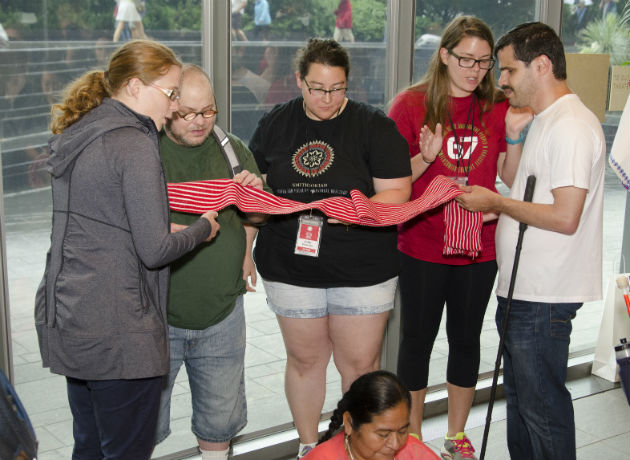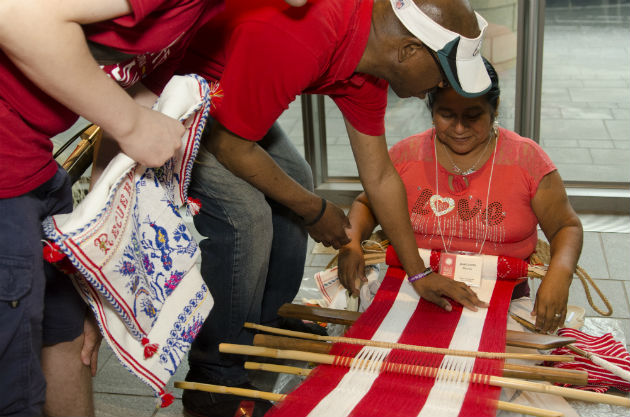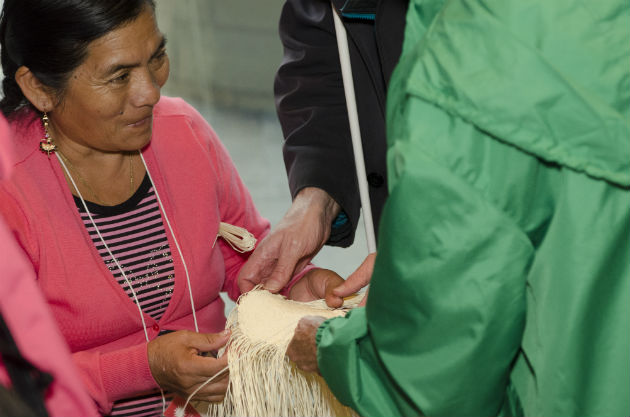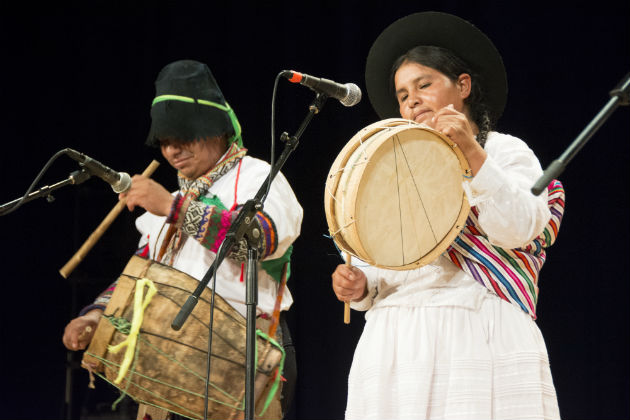Special Event: Tactile and Verbal Description Tours

The rain on June 27 may have pushed the Festival inside the National Museum of the American Indian, but it didn’t stop this year’s first tactile and verbal description tour. Led by Festival accessibility coordinator Lilli Tichinin, the event helps visitors who are blind or have low vision experience Perú: Pachamama.
Each visitor is paired with an intern or volunteer who can verbally describe the environment. “The Festival really is an entire atmosphere,” Tichinin explains. “It’s important to describe the feel of the site as well as physical objects.”
The tour also focuses on objects with unique textures that can provide interesting tactile experiences. This year there was a wide variety of possibilities such as textiles from Cusco, handwoven rope of the Q’eswachaka Bridge, and totora reed rafts.

Co-curator Olivia Cadaval began the tour with an overview of the Peru program. “Talking with a curator gives visitors some context before they began their tour” explains Tichinin. “With her help they were able to ask in-depth questions about the artists and the objects on the tour.”
The visitors then made their way through the craft demonstrations in NMAI’s Potomac Atrium to learn about a variety of art forms.
“The Festival participants were so welcoming and helpful,” volunteer services intern Cyle Cucinotta says. “They encouraged the visitors to touch their art work and ask questions. Margarita Guzmán, the Marinera hat weaver, even let visitors lay their hands over hers while she was weaving so they could feel what she was doing.”

Although the tour began as a group, visitors and their guides split off for more personalized experiences, moving around the museum at their own speed. As Cucinotta explains, the tour’s individualized approach is vital to helping each visitor get the most out of their experience.
“Some people wanted detailed information about who made an object, what it was made of, and what it is used for,” she says. “Other people wanted to focus on exactly what objects looked like. I found that it was best to follow their hands while giving descriptions. That way, I could give real-time commentary as they moved across the artwork.”
Visitors ended their tour by feeling a selection of handmade goods from the Festival Marketplace. “Many of the visitors really liked going to the Marketplace,” Cucinotta says. “The fact that they could feel something on the tour and then buy one to take with them was a great experience.”
Once the tour was over, several visitors stayed to listen to storytelling sessions and performances in the Rasmuson Theater.
Despite the weather, Tichinin is pleased with the outcome of the tour. “The visitors really did take full advantage of the experience, even though they had to adapt to a condensed space.”

“One of my favorite moments was actually after the tour,” she adds. “One of the visitors, whose parents are from Peru, was especially intrigued by the costumes at the Ayacucho Carnaval, a special performance in the Rasmuson by traditional quinoa farmers. She met the participants after the show, both to express her compliments on a wonderful performance and to feel the costumes that she had heard about from the performance presenter.
“What I appreciate about this moment was that it tied the tactile tour to other aspects of the Festival. The tour can be a jumping-off point for visitors’ Festival experiences, but it is by no means limiting and can be just the beginning of exploration at the Festival.”
A second tactile and verbal description tour for Festival visitors who are blind or have low vision for will take place on Thursday, July 2 from 3 to 5 p.m. Weather permitting, this second tour will take place outside on the National Mall.
To join the tour, please RVSP to ensure that each visitor can be paired with a guide. Contact the Smithsonian Accessibility Program at access@si.edu or (202) 633-2921.
Georgia “Ellie” Dassler is a media intern at the Center for Folklife and Cultural Heritage and a student at the College of William & Mary, where she studies anthropology and teaching English to speakers of other languages.

